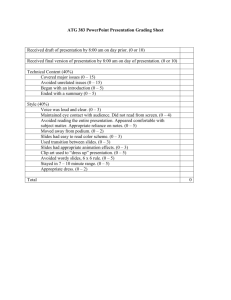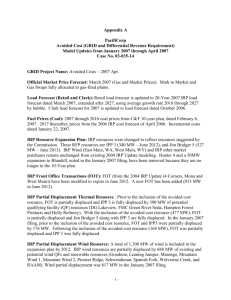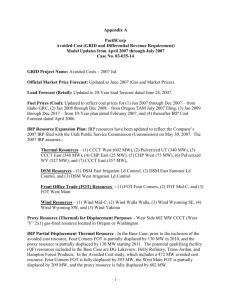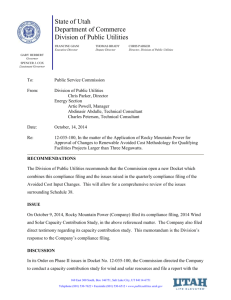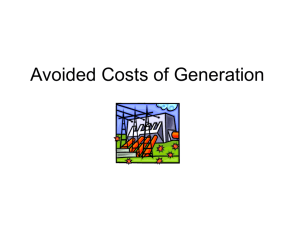Comments from DPU - Utah Public Service Commission
advertisement
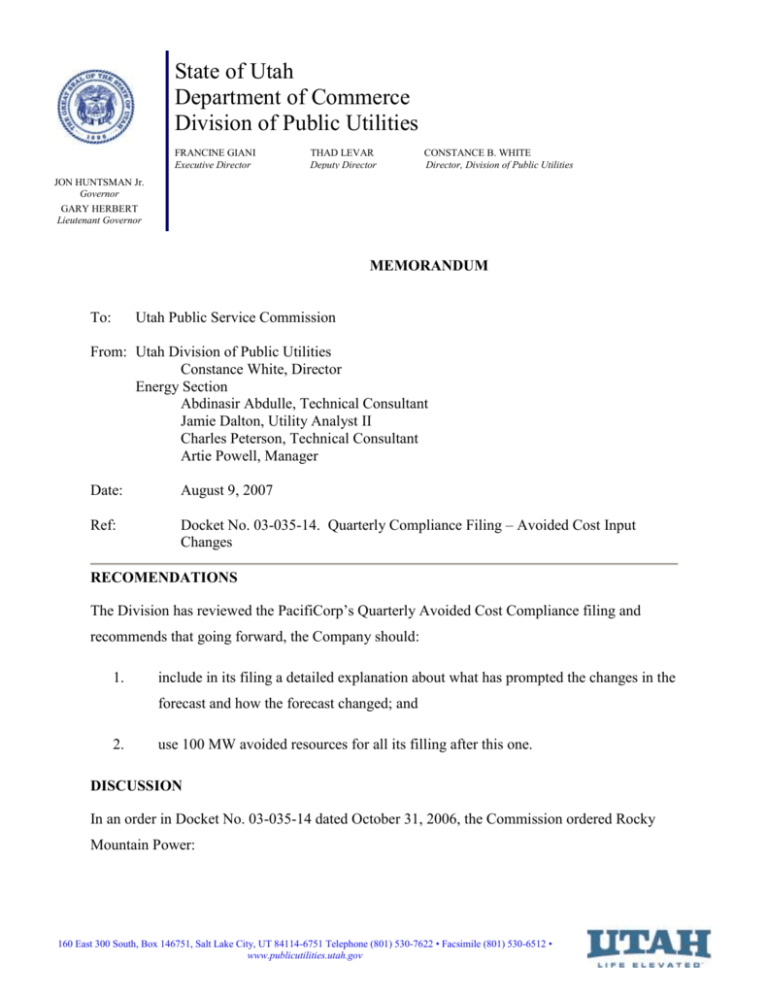
State of Utah Department of Commerce Division of Public Utilities FRANCINE GIANI Executive Director THAD LEVAR Deputy Director CONSTANCE B. WHITE Director, Division of Public Utilities JON HUNTSMAN Jr. Governor GARY HERBERT Lieutenant Governor MEMORANDUM To: Utah Public Service Commission From: Utah Division of Public Utilities Constance White, Director Energy Section Abdinasir Abdulle, Technical Consultant Jamie Dalton, Utility Analyst II Charles Peterson, Technical Consultant Artie Powell, Manager Date: August 9, 2007 Ref: Docket No. 03-035-14. Quarterly Compliance Filing – Avoided Cost Input Changes RECOMENDATIONS The Division has reviewed the PacifiCorp’s Quarterly Avoided Cost Compliance filing and recommends that going forward, the Company should: 1. include in its filing a detailed explanation about what has prompted the changes in the forecast and how the forecast changed; and 2. use 100 MW avoided resources for all its filling after this one. DISCUSSION In an order in Docket No. 03-035-14 dated October 31, 2006, the Commission ordered Rocky Mountain Power: 160 East 300 South, Box 146751, Salt Lake City, UT 84114-6751 Telephone (801) 530-7622 • Facsimile (801) 530-6512 • www.publicutilities.utah.gov To keep a record of any changes, including data inputs, made to the Proxy and GRID models used in this case. The Company shall notify the Commission and Division of any updates they make to the models used in the approved Proxy and PDDRR methods In compliance with the above Commission Order, On May 7, 2007, RMP filed its Quarterly Compliance – Avoided Cost Input Changes. The proposed input changes consist of routine input changes and other input changes. In an action request dated August 7, 2007, the Commission requested that the Division review these updates and report its findings to the Commission by October 10, 2007. This memo contains the Division’s review of RMP’s Quarterly Compliance Filing dated August 3, 2007. Routine Input Changes Official Market Price Forecasts: PacifiCorp’s filing indicates that the GRID model has been updated to reflect its most recent forward price curve dated June 2007. The Division believes this to be an appropriate change in the model. Load Forecast (Retail and BPA South Idaho): The retail load forecast was updated to 20-Year load forecast dated June 24, 2007 to reflect the Company’s most recent available load forecasts. Fuel Price (Coal): The fuel price forecast has been updated to reflect the most recent available forecast. For 2007, fuel prices from the Idaho General Rate Case were used. For 2008, the July filing of the Oregon TAM was used. For 2009 through 2017, the 10Year plan filed in February 2007 was used. Finally, for the period after 2017 the IRP coal forecast dated April 2007 was used. Based on discussions the Division and the Committee had with the Company on October 3, 2007, the Division concludes that this change is appropriate. -2- The Division believes that updating the forecasts to the most recently available forecasts is appropriate. However, the Division is concerned about the fact that the Company does not provide any justification for the changes it makes in the forecasts. Going forward, the Division recommends that the Company include in its filing a detailed explanation about what has prompted the changes in the forecast and how the forecast changed. Although the Company indicated that the avoided costs calculated using these updated inputs will not be used as indicative prices, the Division is concerned that these forecast will be used to develop indicative prices for new QFs that may come in the door. Discount Rate: According to the Company, the Company routinely updates the official discount rate. The last time it was updated was December 2006. In this filing the Company used a discount rate of 7.3% which the current updated discount rate. Other Updates There are a number of other updates that are made to the inputs of the Proxy and the Proxy models. The IRP resource expansion plan is updated reflect the Company’s 2007 IRP. In the May 7, 2007 filing the expansion plan was based on resources suggested by the Commission. The Proxy resource is changed from Jim Bridger 5 to a West side 602 MW CCCT (West “F” 2x1) gas fired resource. The Division thinks that these updates are appropriate. IRP Partial Displacement Thermal Resource: In Docket No. 03-035-14, the Commission ordered that the Partial Displacement Differential Revenue Requirement method be used for the calculation of avoided energy cost to provide indicative pricing to the QFs. In this method two grid runs are performed to calculate avoided energy cost. The first run is the existing utility system plus the planned resources contained in the Company’s Preferred Portfolio in its most recent IRP. The second run is the same as the first run with two exceptions: the operating characteristics of the proposed qualifying facility are added with its energy dispatchable at zero cost and the capacity of the IRP -3- resource is reduced by an amount equal to the QF capacity. The difference in production cost between these two runs is the avoided cost. In this filing, the Company performed two GRID runs, base case and a change case. In both cases the potential resources were treated as existing resources. Thus the capacity of the next deferrable IRP resource was reduced by the capacity of the potential resources in both cases. In the change case, the operating characteristics of the proposed QFs were added with energy dispatchable at zero cost and the capacity of the next deferrable IRP resources was reduced by an amount equal to the capacity of the proposed QFs. The next deferrable IRP resource is the front office transaction and the gas fired resource in 2010 and 2011, respectively. In 2010, the front office transaction (602 MW) was reduced by the capacity of potential resources (130 MW), then the proposed QFs (472 MW) were added to completely displace the front office transaction. Similarly, in 2011, the proxy resource (602 MW) was reduced by the capacity of the potential resources (130 MW), then a 472 MW of proposed QFs were added to completely displace the 602 MW of the gas fired IRP resource. The difference in production cost between the base case run and the change case run is the avoided cost. Though the inclusion of the potential resources is not part of the Commission approved methodology, Company decided to include it in recognition of the fact the first QF that asks for indicative price is expected to replace the most expensive IRP resource, the second QF will replace the second most expensive IRP resource, and so on and so forth. Therefore, it is fair to give the first QF that asks for an indicative price a higher price than the second and to give the second QF higher price than the third, and so on and so forth. This necessitated that the Company put the QFs that asked for indicative prices in a queue. Thus when a proposed QF asks for an indicative price, this price will be calculated with the assumption that all the QFs that came before it signed a contract and are treated as existing. This makes sense to the Division except that there is no limit as to how long a QF can be in the queue without actually signing a contract unfairly pushing prices down to the QFs that walked in the door after it. Currently, the Division is -4- working on a criterion to determine whether a particular QF in the Queue is making a significant progress towards signing a contract. The Division may summit its recommendation on this issue in its memo for the next quarterly filing. In this filing the Company used 472 MWs of avoided resources to completely displace the next deferrable resources. This is contrary to the Commission order. In Docket No. 03-035-14, the Commission ordered that the PDDRR method be used to calculate the avoided energy costs for cogeneration facilities between 1 and 100 MWs and small power production facilities, excluding wind, between 3 and 100 MWs. The proposed 472 MW avoided resources is apparently greater than the 100 MW, upper limit, for this method. In the same Docket, the Commission ordered that QFs greater than 100 MWs must participate in a bidding process whereby the winning bid will receive the bid avoided capacity and energy payments. Therefore, the Division recommends the Company to use 100 MW avoided resources for all its filling after this one. This is consistent with the Commission order and will make it easier for a QF thinking of asking for indicative price to quickly get an idea of the approximate price per MW they will receive. The Division reviewed the reasonableness of all of the other modifications to the Proxy and GRID models. The Division, therefore, concludes that all of the Company’s proposed input updates are reasonable and recommends the Commission to acknowledge it. CC: Rea Petersen, DPU Jeff Larsen, RMP Dave Taylor, RMP Michele Beck, CCS -5-

